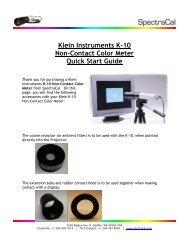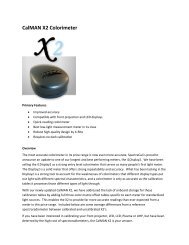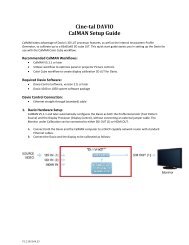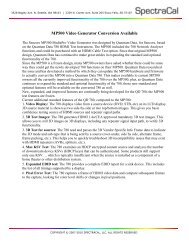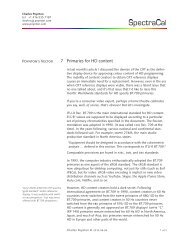Poynton's Vector 11 AMOLED Displays - SpectraCal
Poynton's Vector 11 AMOLED Displays - SpectraCal
Poynton's Vector 11 AMOLED Displays - SpectraCal
You also want an ePaper? Increase the reach of your titles
YUMPU automatically turns print PDFs into web optimized ePapers that Google loves.
Charles Poynton<br />
tel +1 416 535 7187<br />
charles @ poynton.com<br />
www.poynton.com<br />
Poynton’s <strong>Vector</strong> <strong>11</strong> <strong>AMOLED</strong> displays<br />
Considering the part number prefix<br />
BVM (broadcast video monitor),<br />
Sony apparently didn’t take to<br />
heart my suggestion to adopt<br />
anew acronym. See Issue 5.<br />
Irecently attended the Hollywood Post Alliance (HPA) Tech Retreat;<br />
Ipresented a half-day seminar, Studio Reference <strong>Displays</strong>. Some of the<br />
topics that I discussed will be familiar to readers of Poynton’s <strong>Vector</strong>.<br />
In Issue 5, I described how I am retraining myself to use the phrase<br />
studio reference display instead of broadcast video monitor. In issue 6,<br />
I lamented the demise of the CRT as a reference display. However,<br />
things are looking up. At HPA, Dolby (again) demonstrated their<br />
Professional Reference Monitor, which incorporates a spatially modulated<br />
backlight (which in Asia would probably be called local<br />
dimming). They have demonstrated it at previous events; this time, it’s<br />
close to commercial availability.<br />
As exciting as the Dolby display was Sony’s demonstration of<br />
a 24.5-inch <strong>AMOLED</strong> studio reference display. It has a part number,<br />
BVM-E250, and it is expected to be commercially available in May, for<br />
a few tens of thousands of dollars. It comes from a new factory that<br />
has been quoted as requiring an investment of $200M (US). Clearly,<br />
Sony can’t recoup that investment from professional markets alone:<br />
We can expect this display technology to be introduced into consumer<br />
electronics.<br />
About 3 years ago, shortly after discontinuing CRTs, Sony introduced<br />
the BVM-L230 reference display. The L230 comprised an LCD<br />
panel with an RGB LED backlight unit. The introduction event took<br />
place in a dark room where two L230s were placed alongside a reference-grade<br />
CRT BVM; all were displaying the same picture. The visitor<br />
was challenged to identify which was the CRT. You could argue that<br />
the source material was carefully chosen, but in my opinion the Sony<br />
engineers quite successfully managed to get the L230 to mimic CRT<br />
behaviour. However, the L230 emitted about 0.15 nt when driven with<br />
reference black signal level (equivalent to a contrast ratio of about<br />
700:1): The blacks weren’t very black, and studio users weren’t too<br />
impressed. The L230 model didn’t do very well, and it was shortly<br />
followed by a somewhat improved model – the BVM-L231 – which<br />
still didn’t produce blacks adequately dark for mastering content.<br />
Sony’s 3-display setup was repeated at HPA for the E250 demonstration;<br />
however in this case it was interesting that Sony made no<br />
attempt to mimic the studio CRT black level of about 0.03 nt (a contrast<br />
ratio of about 3000:1): When the video signal goes to reference<br />
black level, an <strong>AMOLED</strong> emits no light; the display is pitch black. The<br />
<strong>AMOLED</strong> images were quite different from those on the CRT.<br />
Charles Poynton © 20<strong>11</strong>-03-09 12:29 1 of 2
<strong>AMOLED</strong> DISPLAYS 2<br />
The luminance produced by code 0 is relevant to the appearance of<br />
displayed pictures. Code 1 is also relevant. Let’s compute:<br />
Eq <strong>11</strong>.1<br />
Eq <strong>11</strong>.2<br />
Eq <strong>11</strong>.3<br />
Here I use video code level 0 for<br />
reference black and code 219<br />
for reference white. You might<br />
be expecting codes 16 and 235,<br />
but those are interface codes.<br />
Calculations such as mine are<br />
greatly simplified if the interface<br />
offset of +16 is first subtracted.<br />
See Issue 4.<br />
Eq <strong>11</strong>.4<br />
Poynton, Charles (2009), “Perceptual<br />
uniformity in Digital Imaging,” in<br />
Proc. Gjøvik Color Imaging<br />
Symposium (GCIS 2009): 102–109.<br />
22 .<br />
⎛ 1 ⎞<br />
1<br />
0 000 005 077<br />
⎝<br />
⎜<br />
255⎠<br />
⎟ ≈ .<br />
≈<br />
197 000<br />
24 .<br />
⎛ 1 ⎞<br />
1<br />
⎝<br />
⎜<br />
219⎠<br />
⎟ ≈ 0.<br />
000 002 415 ≈<br />
400 000<br />
24 .<br />
⎛ 1 ⎞<br />
1<br />
0.<br />
000 000 091<br />
⎝<br />
⎜<br />
858⎠<br />
⎟ ≈ ≈ <strong>11</strong>000 000<br />
The first equation calculates the relative luminance expected from<br />
the 8-bit sRGB code value used in personal computers, assuming<br />
2.2-gamma and no ambient light. Code 1 (on a scale of 0 to 255) has<br />
equivalent contrast ratio of about 200 000:1. In any reasonable<br />
viewing environment, no one could be expected to see that light.<br />
The second equation calculates the relative luminance expected<br />
from the HD or SD 8-bit code values typical of consumer equipment,<br />
assuming 2.4-gamma, and again assuming no ambient light. Code 1<br />
(now on a scale of 0 to 219) has equivalent contrast ratio of about<br />
400 000:1. Again, no one could be expected to see code 1.<br />
The third equation calculates the relative luminance expected from<br />
10-bit studio video coding, with the same assumptions. Equivalent<br />
contrast ratio is <strong>11</strong> million to 1. Again, no one can see code 1.<br />
Digging deeper into the visibility of video signal codes, we can ask,<br />
what is the ratio of luminances produced by codes 1 and 2?<br />
24 .<br />
24 .<br />
⎛ 2 ⎞<br />
⎛ 22 ⎞<br />
⎛ 219⎞<br />
⎝<br />
⎜ 219⎠<br />
⎟<br />
⎝<br />
⎜ 219⎠<br />
⎟<br />
⎝<br />
⎜ 219⎠<br />
⎟<br />
= 5. 278 ;<br />
= 1. <strong>11</strong>8 ;<br />
= 1.<br />
0<strong>11</strong><br />
24 .<br />
24 .<br />
24 .<br />
⎛ 1 ⎞<br />
⎛ 21 ⎞<br />
⎛ 218⎞<br />
⎝<br />
⎜ 219⎠<br />
⎟<br />
⎝<br />
⎜ 219⎠<br />
⎟<br />
⎝<br />
⎜ 219⎠<br />
⎟<br />
At the left is the answer for the 8-bit consumer video situation. The<br />
luminance ratio between the first two codes is about five to one:<br />
Going from code 1 to code 2 multiplies the luminance by five. At first<br />
glance, that factor is surprisingly large; however, it turns out to be<br />
entirely consistent with the behaviour of vision at very low<br />
luminances. As code value increases, the ratio diminishes; at code 22<br />
(about 10% video level), the luminance ratio between adjacent video<br />
codes is about 1.1, and at reference white, the ratio has fallen to<br />
about 1.01 (the nominal one percent Weber contrast of vision science).<br />
The traditional power law of video is well matched to perception,<br />
even at eight bits. But, home theatre calibrators know that 8-bit<br />
plasma panels – the very early ones – performed very poorly, exhibiting<br />
severe banding artifacts. Why? They were 8-bit linear light devices.<br />
The luminance ratios between adjacent panel driving codes didn’t<br />
match visual perception. The solution for PDPs was to increase the bit<br />
depth driving the panel – and to add spatial and/or temporal dither.<br />
For <strong>AMOLED</strong> displays, one open question is this: What is the native<br />
“law” by which the OLED driving codes are translated to luminance?<br />
I could tell from examining the BVM-E250 images that its characteristic<br />
wasn’t linear. However, it’s highly unlikely that <strong>AMOLED</strong>s exhibit<br />
the power-function behaviour of CRTs. When I find out, and piece<br />
together the implications for image quality, I’ll let you know!<br />
24 .







